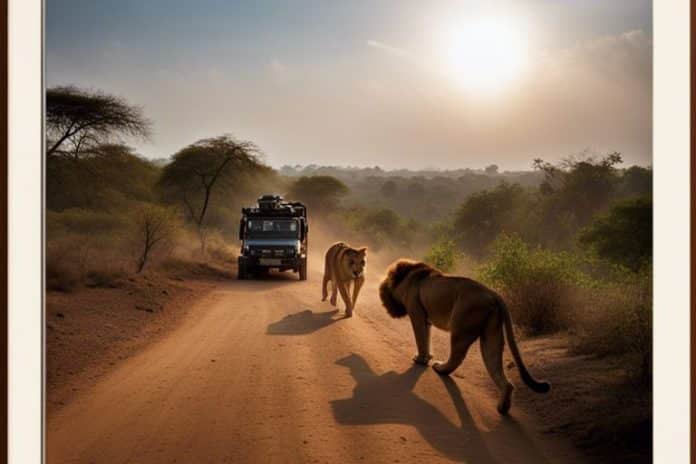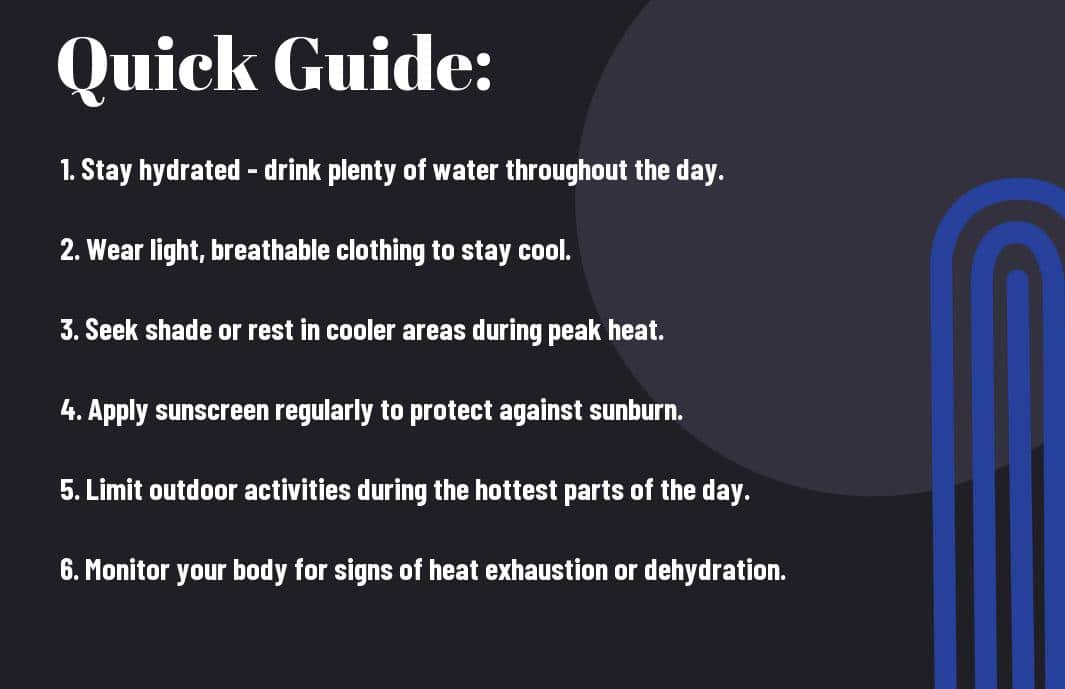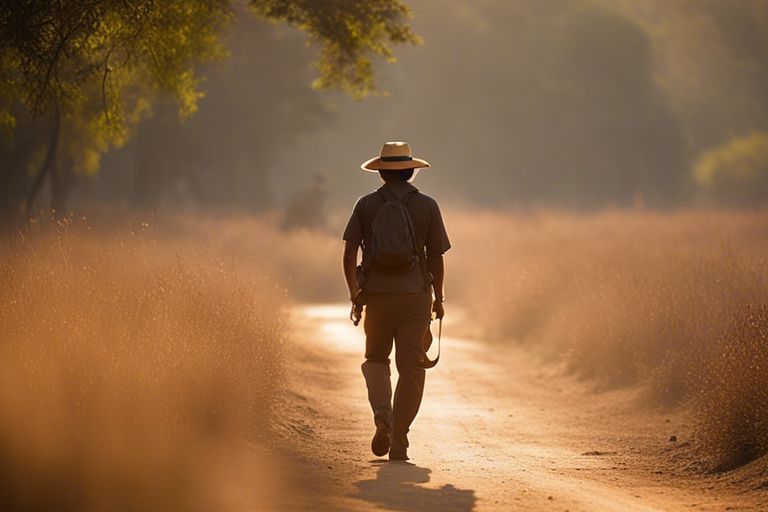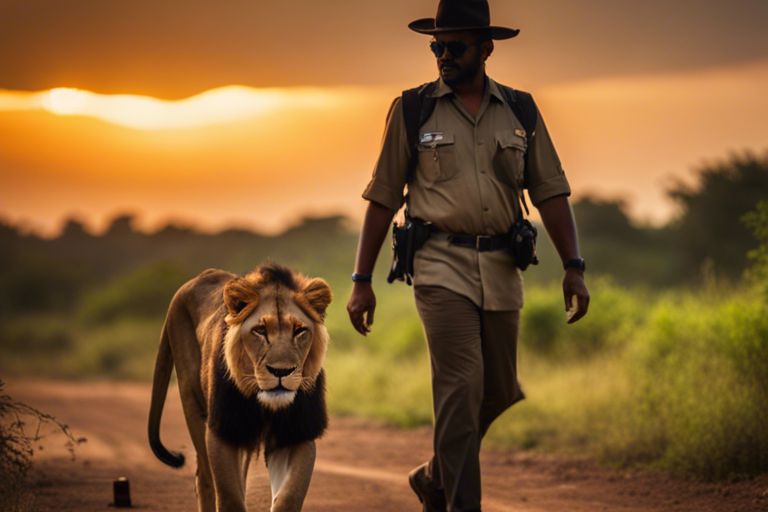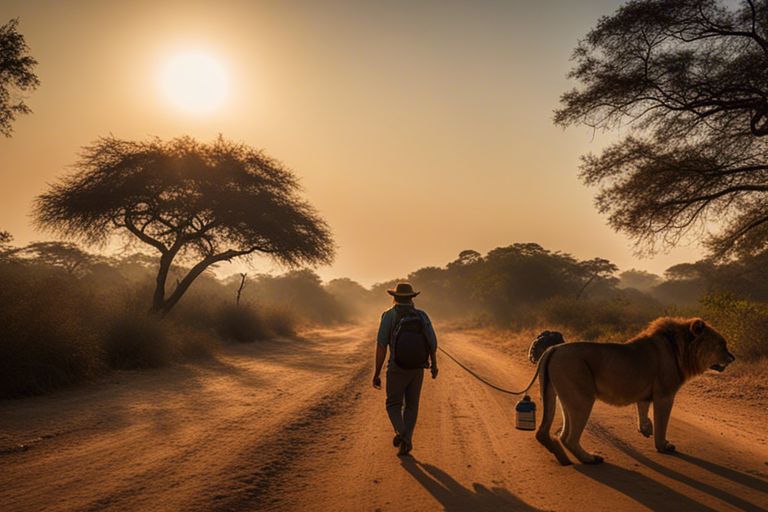Most travelers find themselves taken aback by the intense heat of Gir Forest, home to a diverse range of wildlife, including the majestic Asiatic lions. The temperatures in this region can soar to dangerously high levels, making it crucial to be well-prepared before launching on any outdoor adventures.
From scorching afternoons to cool evenings, the temperature in Gir Forest can vary significantly throughout the day. It is important to pack light, breathable clothing and plenty of water to stay hydrated and comfortable in the unforgiving heat. Additionally, seeking shade during the hottest parts of the day can help prevent heat exhaustion or heat stroke.
Despite the challenging climate, witnessing the incredible wildlife and lush landscapes of Gir Forest can be a rewarding experience. With the right preparation and respect for nature’s power, visitors can safely navigate the heat and create unforgettable memories in this stunning region.
Key Takeaways:
- Stay Hydrated: It is important to drink plenty of water to prevent dehydration in the scorching heat of Gir Forest.
- Dress Light: Wearing loose and light-colored clothing will help in staying cool and comfortable in high temperatures.
- Seek Shade: Find shade under trees or use umbrellas to avoid direct exposure to the sun during the hottest parts of the day.
- Time Your Visits: Plan your activities early in the morning or late in the evening to avoid the peak heat hours between 11 am to 3 pm.
- Wear Sun Protection: Use sunscreen, sunglasses, and hats to protect your skin and eyes from the harmful effects of UV rays.
- Know the Warning Signs: Learn the symptoms of heat exhaustion and heatstroke such as dizziness, nausea, and rapid heartbeat, and seek help if you experience any of them.
- Listen to Your Body: Pay attention to your body’s signals and take breaks when needed to prevent overheating and heat-related illnesses.
Understanding Temperature Types in Gir Forest
If you’re planning a trip to Gir Forest, it is vital to understand the different types of temperatures you may encounter. Having this knowledge will help you better prepare and stay safe during your visit. Here is a breakdown of the temperature types you can expect in Gir Forest:
| Cool Temperatures | Warm Temperatures |
| During the early morning and late evening, temperatures can drop significantly, especially during the winter months. | The midday sun brings warmer temperatures, which can be quite intense, particularly in the summer. |
| Hot Summers | Chilly Winters |
| Summers can be scorching in Gir Forest, with temperatures soaring to high levels, especially during peak afternoon hours. | Winter nights can be quite chilly, so make sure to carry appropriate clothing to stay warm. |
| Humid Monsoons | |
| The monsoon season brings humidity to Gir Forest, with occasional rainfall providing relief from the heat. |
Seasonal Temperature Variations
Types of temperatures in Gir Forest vary significantly throughout the year. During the summer months, the forest experiences hot and dry conditions, with temperatures reaching their peak in the afternoon. In contrast, winter brings cool and crisp weather to the region, with chilly nights requiring additional layers for warmth. The monsoon season sees a shift towards humid and muggy conditions, providing some respite from the intense heat of summer.
| Summer | Winter |
| Hot and dry conditions with peak temperatures in the afternoon. | Cool and crisp weather with chilly nights. |
Diurnal Temperature Fluctuations
Fluctuations in temperature throughout the day are significant in Gir Forest. The difference between daytime and nighttime temperatures can be quite dramatic, with daytime temperatures rising considerably and nighttime temperatures dropping rapidly. It is crucial to be prepared for these fluctuations and dress accordingly to stay comfortable during your visit.
| Daytime | Nighttime |
| Temperature rises significantly during the day. | Temperatures drop rapidly at night. |
Any sudden changes in temperature can pose challenges to your comfort and well-being during your time in Gir Forest. By understanding these temperature types and variations, you can better plan and equip yourself for a safe and enjoyable experience in this unique habitat.
Factors Influencing Gir Forest’s Temperatures
Many factors contribute to the temperatures experienced in the Gir Forest, home to the majestic Asiatic lions. These factors play a crucial role in shaping the climate and environment of the region. Understanding these influences can help visitors better prepare for their trip and appreciate the unique ecosystem of this wildlife sanctuary.
- Geographic Location: Gir Forest is located in the state of Gujarat in western India. Its proximity to the Arabian Sea influences the temperatures, leading to hot and dry summers and mild winters.
- Altitude: The terrain of Gir Forest varies in altitude, ranging from 50 to 600 meters above sea level. This variation results in temperature changes across different parts of the forest.
Geographic Factors
For visitors to Gir National Park in Gujarat, understanding the geographic factors that impact temperatures is necessary. The region’s location near the coast exposes it to maritime influences, resulting in relatively high humidity levels. Additionally, the forest’s topography, with its mix of hills and plains, contributes to local weather patterns. Altitude also plays a crucial role, with higher regions experiencing cooler temperatures than lower-lying areas.
- Monsoons: The southwest monsoon brings rainfall to Gir Forest between June and September, providing relief from the scorching summer heat. The northeast monsoon in October and November also influences temperatures, impacting the region’s climate.
- Seasonal Variations: Gir Forest experiences distinct seasonal changes, with summer temperatures soaring above 40°C and winter temperatures dropping to around 10°C. These fluctuations affect both the flora and fauna of the region.
Effects of Flora and Fauna on Local Climate
While the geographic factors play a significant role in shaping Gir Forest’s temperatures, the presence of diverse flora and fauna further influences the local climate. The dense vegetation in the forest provides shade and helps regulate temperatures, creating microclimates that support a variety of species. The Asiatic lions, in particular, have adapted to the hot conditions of the region, finding refuge in the forest’s cooler areas during the day.
Geographic features such as rivers and water bodies also impact temperatures in Gir Forest. These water sources provide necessary hydration for the wildlife and influence humidity levels in the surrounding areas. The presence of various tree species contributes to the overall cooling effect of the forest, making it a vital habitat for diverse flora and fauna.
The combination of geographic factors and the presence of flora and fauna creates a unique ecosystem in Gir Forest, with temperatures varying across different habitats. Knowing how these elements interact can help visitors appreciate the biodiversity of the region and the delicate balance that supports its wildlife. The Gir National Park in Gujarat – Responsible Travel offers insights into how sustainable practices can help preserve this natural environment for future generations.
Preparing for Heat: A Step-by-Step Guide
All visitors to Gir Forest must be well-prepared for the extreme heat that often characterizes this region. The scorching temperatures can be challenging, but with the right preparations, you can enjoy your time in the forest comfortably. This guide will walk you through the steps to take to ensure you are ready for the heat and can make the most of your experience in Gir Forest.
Step 1: Knowing When to Visit
| Little Crowded Seasons | Peak Visitation Months |
| Choose to visit during the months of November to March, which are considered the off-peak season. During this time, the weather is milder, and the number of tourists is lower, allowing for a more peaceful experience in the forest. | Avoid visiting during the peak summer months of April to June when temperatures can soar above 40 degrees Celsius. The heat during these months can be unbearable and might hinder your enjoyment of the wildlife safari and outdoor activities. |
Planning your visit during the right season is crucial for a comfortable experience in Gir Forest. By avoiding the peak summer months and opting for the less crowded seasons, you can make the most of your trip without the discomfort of extreme heat and overcrowding.
Step 2: What to Pack for the Climate
| Light Clothing | Essential Accessories |
| Pack lightweight, breathable clothing such as cotton outfits that can help you stay cool in the hot weather. Avoid dark-colored clothes that absorb heat and opt for lighter shades that reflect sunlight. | Remember to pack vitals like a wide-brimmed hat, sunglasses, sunscreen, and a reusable water bottle to stay hydrated throughout your time in the forest. These accessories will provide protection from the sun and help you beat the heat. |
When preparing for your trip to Gir Forest, it is vital to pack the right clothing and accessories to cope with the hot climate. By choosing lightweight, breathable outfits and vital accessories for sun protection, you can stay comfortable and safe while exploring the wildlife and natural beauty of the forest.
Step 2: Knowing what to pack for the climate is vital to ensure you have a pleasant and comfortable experience in Gir Forest. By packing the right clothing and accessories, you can protect yourself from the intense heat and sun exposure, allowing you to focus on enjoying the wildlife and scenic landscapes.
Step 3: Acclimatization Techniques
| Slow Exposure | Stay Indoors During Peak Heat |
| Acclimatize to the heat gradually by spending short periods outdoors before your trip to Gir Forest. This will help your body adjust to the high temperatures and reduce the risk of heat-related illnesses during your visit. | Avoid outdoor activities during the peak heat hours of the day, typically between 11 am to 3 pm. Instead, plan your sightseeing and wildlife safaris during the early morning or late afternoon when the temperatures are milder. |
Acclimatization is key to staying safe in the heat of Gir Forest. By gradually exposing yourself to the high temperatures and avoiding peak heat hours, you can protect yourself from heat exhaustion and ensure a more enjoyable experience exploring the forest.
Step 3: Acclimatization techniques are vital for preparing your body to handle the extreme heat in Gir Forest. By acclimating slowly and avoiding peak heat hours, you can reduce the risk of heat-related illnesses and have a more comfortable visit to the forest.
Step 4: Staying Hydrated and Nourished
| Drink Plenty of Water | Healthy Snacks |
| Stay hydrated by drinking plenty of water throughout the day, especially in the hot weather. Carry a reusable water bottle and refill it at designated water stations to ensure you remain hydrated during your explorations. | Pack healthy snacks like nuts, fruits, and energy bars to keep your energy levels up while trekking or on wildlife safaris. These nutritious snacks will provide a boost of energy and help you sustain your activities in the heat. |
With the intense heat in Gir Forest, staying hydrated and nourished is crucial for your well-being and enjoyment of the surroundings. By drinking plenty of water and carrying healthy snacks, you can maintain your energy levels and stay refreshed throughout your adventures in the forest.
Techniques: Staying hydrated and nourished is vital for combating the extreme heat in Gir Forest. By following these important tips, you can protect yourself from dehydration and heat-related illnesses, ensuring a safe and memorable experience in the forest.
Tips for Managing Heat Exposure
Despite the scorching temperatures in Gir Forest, there are ways to manage heat exposure and stay safe during your visit. Here are some vital tips to help you combat the intense heat:
- Stay Hydrated: Drink plenty of water throughout the day to prevent dehydration.
- Seek Shade: Find shade under trees or use umbrellas to protect yourself from direct sunlight.
- Wear Light Clothing: Opt for lightweight and breathable fabrics to help you stay cool.
- Use Cooling Accessories: Carry a portable fan, cooling towel, or hat to help lower your body temperature.
- Plan Your Activities: Schedule outdoor activities during the cooler parts of the day to avoid the peak heat.
The 3 Days Gir Forest Lion Safari offers a guided tour that includes tips on managing heat exposure while exploring the magnificent wildlife of Gir Forest.
Finding Shade and Creating Shelter
Finding shade is crucial in the scorching heat of Gir Forest. Look for trees or rock formations that can provide shelter from the sun. If you’re out in the open, consider bringing a lightweight tent or setting up a makeshift shelter using a tarp. Creating shade will help you cool down and prevent heat-related illnesses.
Understanding and Utilizing the Cool Hours
Clearly, early mornings and late evenings are the coolest times in Gir Forest. Take advantage of these hours to engage in outdoor activities or go for a safari when the temperatures are more bearable. During the midday heat, consider taking a break indoors or in shaded areas to avoid overheating and sunburn.
With proper planning and awareness of the cool hours, you can make the most of your time in Gir Forest while staying safe and comfortable.
Clothing and Gear for Optimal Cooling
An vital part of managing heat exposure is wearing the right clothing and gear. Opt for light-colored, loose-fitting clothes that allow air circulation and help sweat evaporate. Additionally, wearing a wide-brimmed hat, sunglasses, and sunscreen will provide added protection from the sun’s harmful rays. Bring a small backpack with vitals like a water bottle, snacks, and a first aid kit to stay prepared for any situation.
Understanding the importance of proper clothing and gear is crucial for staying cool and comfortable in the extreme heat of Gir Forest. Make sure to prioritize your safety and well-being by dressing appropriately for the conditions.
Technologies and Tools to Combat the Heat
Personal Cooling Devices
Keep yourself cool and comfortable in the scorching heat of Gir Forest with the help of personal cooling devices. These innovative gadgets are designed to provide instant relief from the sweltering temperatures, allowing you to enjoy your time in the wilderness without succumbing to heat exhaustion. From portable fans to wearable air conditioners, there are various options available to help you beat the heat during your outdoor adventures.
With advancements in technology, personal cooling devices have become more efficient and convenient than ever before. Some devices come with rechargeable batteries, ensuring that you can stay cool for extended periods without worrying about running out of power. Additionally, lightweight and compact designs make these devices easy to carry around, whether you’re trekking through the rugged terrain or simply relaxing at your campsite.
Whether you’re exploring the dense forests or observing the majestic wildlife of Gir, personal cooling devices can make all the difference in ensuring a comfortable and enjoyable experience in the midst of extreme heat.
Advancements in Heat-Resistant Materials
If you find yourself in need of reliable gear that can withstand the intense heat of Gir Forest, look no further than advancements in heat-resistant materials. These cutting-edge materials are designed to provide optimal protection against high temperatures, ensuring durability and performance in the harshest of environments. From heat-resistant clothing to insulated water bottles, these materials are necessary for staying safe and comfortable in extreme conditions.
Another noteworthy application of heat-resistant materials is in the construction of shelters and camp equipment. Tents made from heat-resistant fabrics can help maintain a comfortable temperature inside, offering a retreat from the blistering heat outside. Additionally, cooking utensils and camping gear made from these materials ensure safe and efficient use, even in the most challenging conditions.
If you’re planning a trip to Gir Forest, investing in gear made from heat-resistant materials can provide you with the peace of mind and confidence to explore the wilderness without worrying about the impact of the soaring temperatures on your equipment.
Staying Safe in Extreme Temperatures
Once again, if you are planning a trip to Gir Forest during the hot season, it’s vital to be well-prepared for the extreme temperatures that can reach over 40°C (104°F). For a comprehensive guide on exploring the Gir National Park, check out Your Travel Guide to the Royal Kingdom of Asiatic Lions before your journey.
| Recognizing Heat-Related Illnesses | First Aid for Heat Stroke and Dehydration |
Recognizing Heat-Related IllnessesFor those exploring Gir Forest in the scorching heat, it’s crucial to be able to recognize the signs of heat-related illnesses such as heat exhaustion and heat stroke. Symptoms include dizziness, nausea, rapid heartbeat, confusion, and even loss of consciousness. It’s important to immediately move to a shaded or cooler area, hydrate with water or electrolyte drinks, and remove excess clothing to cool down the body. Seek medical help if symptoms persist or worsen. If someone around you shows signs of heat stroke, call for emergency medical assistance immediately. While waiting for help, try to cool the person down by applying wet cloths or ice packs to the body and fan them to reduce body temperature. |
First Aid for Heat Stroke and DehydrationStaying hydrated is key to preventing heat-related illnesses. Make sure to drink plenty of water, even if you don’t feel thirsty. Avoid alcoholic and caffeinated beverages as they can dehydrate the body further. If you suspect someone is suffering from heat stroke or dehydration, it’s crucial to act quickly. Move them to a cool place, loosen tight clothing, and provide water to drink. Keep monitoring their condition until medical help arrives. Plus, educate yourself and your travel companions on the importance of recognizing the early signs of heat-related illnesses and taking preventive measures to stay safe and enjoy your time in Gir Forest. |
Wildlife Concerns in Hot Weather
With temperatures soaring, it’s not just humans who are affected by the heat in Gir Forest. Wildlife in the region also face challenges in finding water sources and regulating their body temperatures. It’s crucial to be aware of the impact of hot weather on the animals’ habitat and behavior and ensure minimal disturbance to their natural environment.
Concerns about wildfires are heightened during the dry and hot season in Gir Forest. The risk of forest fires increases significantly, posing a threat to the flora and fauna of the park. Visitors are advised to follow all guidelines and regulations to prevent accidental fires and help protect the ecosystem.
For both your safety and the well-being of the wildlife, it’s important to respect the natural habitat and take necessary precautions to minimize any negative impact during your visit to Gir Forest. Keep in mind, by being responsible and aware, you can help preserve the beauty and biodiversity of this remarkable ecosystem.
Heat Mitigation Strategies for Hikers & Campers
Not all hikers and campers are aware of the importance of planning their route and timing when exploring Gir Forest in high temperatures.
Route Planning and Timing
For those venturing out in the heat, it is crucial to consider the duration of the trek and the availability of shade along the trail. Opt for early morning or late afternoon hikes to avoid the peak heat hours. Plan your breaks strategically in shaded areas or near water sources to keep cool and hydrated.
Setting up camp in scorching temperatures requires careful consideration and preparation.
Setting up Camp in the Heat
Some necessary tips include choosing a shaded campsite, pitching your tent strategically to catch any available breeze, and setting up a portable canopy for added shade. It’s also advisable to avoid setting up camp near reflective surfaces like rocks or lakes that can intensify the heat.
It is crucial to conserve energy and morale while camping in high temperatures.
Conserving Energy and Maintaining Morale in High Temperatures
If you find yourself feeling fatigued, take frequent breaks in shaded areas and stay hydrated. Wear lightweight, breathable clothing and use cooling towels or misting fans to stay refreshed. Keep morale high by engaging in light activities during the cooler hours of the day and enjoying a hearty, hydrating meal in the evening.
If you want to ensure a safe and enjoyable outdoor experience in hot temperatures, it’s necessary to prioritize heat mitigation strategies. This includes proper route planning, strategic camp setup, and maintaining energy levels and morale throughout your adventure. Refer to the table below for a summarized list of key points:
| Key Strategies | Details |
| Route Planning | Choose shaded trails, hike during cooler hours, and plan breaks in shaded areas. |
| Camp Setup | Pick a shaded campsite, pitch tent strategically for airflow, and avoid reflective surfaces. |
| Energy Conservation | Take frequent breaks, wear breathable clothing, stay hydrated, and engage in light activities. |
Pros and Cons of Experiencing the Heat in Gir Forest
Unlike many other destinations, the Gir Forest presents a unique set of opportunities and challenges when it comes to experiencing the heat. Understanding the pros and cons can help visitors prepare for their trip and make the most of their time in this beautiful and diverse ecosystem.
Pros: The Unique Beauty and Wildlife Experiences
The heat in Gir Forest may be intense, but it also creates a unique environment that is home to a wide variety of plant and animal species. The lush greenery, vibrant flowers, and towering trees all thrive in the heat, creating a stunning backdrop for visitors to explore. Additionally, the wildlife in Gir Forest is truly a sight to behold, with species such as Asiatic lions, leopards, and deer roaming freely in their natural habitat.
Exploring the forest in the heat also provides the opportunity to witness unique behaviors and adaptations of the animals that call Gir Forest home. From watching lions laze in the shade to observing birds and insects go about their daily routines, the heat brings a different perspective to wildlife viewing that is both fascinating and rewarding.
Visitors who brave the heat in Gir Forest are rewarded with unforgettable experiences that few other places can offer. The beauty and diversity of the landscape, combined with the chance to see rare and majestic wildlife up close, make enduring the high temperatures more than worth it for those who appreciate the wonders of nature.
Cons: Physical Challenges and Health Risks
While the heat in Gir Forest can provide unforgettable experiences, it also presents significant physical challenges and health risks. The high temperatures can quickly lead to dehydration and heat exhaustion, especially for those who are not accustomed to such intense heat. It is crucial for visitors to stay hydrated, take regular breaks in the shade, and listen to their bodies to avoid heat-related illnesses.
Additionally, the heat can make physical activities more strenuous and tiring, leading to fatigue and increased risk of injury. Hiking, biking, or even just walking through the forest in the heat can be more challenging than in milder climates, requiring visitors to pace themselves and take precautions to avoid overexertion.
Physical exertion in the heat can also exacerbate existing health conditions and pose a greater risk to individuals with certain medical concerns. It is important for visitors to be aware of their own physical limitations and take steps to protect their health while exploring Gir Forest in the heat.
Educational Programs and Resources
Guided Tours and Workshops on Weather Preparedness
Now, when visiting Gir Forest, it’s crucial to take advantage of guided tours and workshops that focus on weather preparedness. There’s no doubt that the temperatures in the region can be extreme, so being equipped with the right knowledge and skills is vital for your safety. These programs are designed to educate visitors on how to handle the heat, avoid dehydration, and recognize signs of heat-related illnesses. Expert guides will lead you through the forest while providing valuable insights and tips on how to stay safe in the challenging weather conditions.
Participating in these guided tours and workshops will not only enhance your understanding of the environment but also equip you with practical skills to navigate the heat effectively. You’ll learn about the local flora and fauna, as well as how they have adapted to survive in the scorching climate. Additionally, instructors will demonstrate how to properly hydrate, dress, and pace yourself during your time in the forest. By the end of the program, you’ll feel more confident in facing the challenges that the weather may present.
With the help of experienced guides and hands-on activities, you’ll gain a deeper appreciation for the unique ecosystem of Gir Forest while also learning valuable techniques for staying safe in high temperatures. These educational opportunities are not just about surviving the heat but also understanding and respecting the natural world around you. Bear in mind, preparation and knowledge are key when exploring this remarkable, yet demanding, environment.
Literature and Online Resources for Further Learning
Weather can change rapidly in Gir Forest, making it vital to educate yourself through literature and online resources for further learning. Books, articles, and websites dedicated to weather preparedness, local climate patterns, and survival skills can provide valuable insights that complement your on-site experiences. Understanding the environment and how to adapt to its challenges will greatly enhance your visit and ensure your safety.
There are a plethora of resources available that explore into topics such as heat management, first aid for heat-related illnesses, and wildlife behavior in extreme temperatures. By delving into this literature and online content, you can deepen your knowledge and better prepare yourself for the conditions you may encounter in Gir Forest. Bear in mind, being proactive in educating yourself is the best way to enjoy a safe and enriching experience in this unique wilderness.
Guided tours and workshops are invaluable, but supplementing your learning with additional resources can further enrich your understanding of the challenges and wonders of Gir Forest. Arm yourself with knowledge from reputable sources to ensure you make the most of your visit and cherish the memories for years to come.
Conclusion
The Gir Forest is a unique and diverse ecosystem that poses challenges to both wildlife and visitors due to its extreme temperature fluctuations. By understanding the temperature patterns and preparing adequately, visitors can fully appreciate the beauty and wonder of this magnificent forest. From wearing appropriate clothing to staying hydrated and seeking shade when needed, surviving the heat in Gir Forest is possible with the right precautions.
The importance of respecting the environment and its inhabitants cannot be overstated when visiting Gir Forest. By keeping a safe distance from the wildlife and following the guidelines set forth by the forest authorities, visitors can ensure a memorable and enjoyable experience while minimizing disturbances to the natural habitat. Additionally, being mindful of the impact of our actions on the ecosystem will help preserve the delicate balance that sustains life in Gir Forest for generations to come.
In brief, Gir Forest offers a unique opportunity to witness the wonders of nature up close, but it also demands a level of preparation and respect for the environment. By following the tips and guidelines provided in this guide, visitors can navigate the challenges posed by the heat and fully immerse themselves in the sights and sounds of this remarkable forest. With a combination of knowledge, awareness, and respect, surviving the heat in Gir Forest can be a rewarding and unforgettable experience.
FAQ
Q: What is the temperature like in Gir Forest?
A: The temperature in Gir Forest can reach high levels, especially during the summer months, with temperatures often exceeding 40 degrees Celsius (104 degrees Fahrenheit).
Q: How can one stay safe in extreme heat conditions in Gir Forest?
A: To stay safe in extreme heat conditions in Gir Forest, it is necessary to stay hydrated, wear light and breathable clothing, and seek shade during the hottest parts of the day.
Q: What are some tips for staying hydrated in Gir Forest?
A: It is crucial to drink plenty of water and electrolyte-rich fluids to stay hydrated in Gir Forest. Avoid caffeinated and alcoholic beverages as they can lead to dehydration.
Q: What wildlife precautions should be taken in Gir Forest during hot weather?
A: During hot weather in Gir Forest, it is important to be cautious of wildlife, especially predators like lions. Avoid walking alone and stay on designated paths to reduce the risk of encountering aggressive animals.
Q: How can one protect themselves from sunburn in Gir Forest?
A: To protect yourself from sunburn in Gir Forest, wear a wide-brimmed hat, sunglasses, and apply sunscreen with a high SPF regularly. Seek shade whenever possible to avoid prolonged sun exposure.
Q: What are the signs of heat exhaustion to watch out for in Gir Forest?
A: Signs of heat exhaustion in Gir Forest include heavy sweating, weakness, dizziness, nausea, and muscle cramps. If you or someone else shows these symptoms, move to a cooler area and seek medical help if necessary.
Q: Are there any specific clothing recommendations for visiting Gir Forest in hot weather?
A: When visiting Gir Forest in hot weather, it is recommended to wear light-colored, loose-fitting clothing made from breathable fabrics like cotton. This helps to keep your body cool and prevents overheating.
